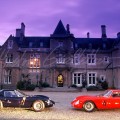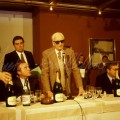Craig Jackson Interview – The Auction House King Of The Hill
Automotive Auction House King
There’s no doubting who is King of the Hill during January’s auction week in Arizona. Over the past 15+ years Barrett-Jackson impresario Craig Jackson has had incredible success, so much so that as I walked through his cathedral-sized auction tent last year with a very well connected market insider, the insider postulated “This week Craig will make more money than all the other auctions combined.”
So who exactly is the man behind the often 1,400-plus car extravaganza in Scottsdale, and what makes him and his sale tick?
“I get branded ‘just muscle cars,’” Jackson says, “but when I took over the company in the mid-1990s I really looked at the focus as postwar cars. I (saw) the demographics of the baby boomer generation and how much money they are going to make and said, ‘They will probably want to go buy the cars they can relate to, just like the World War II generation (did).’”
No question that was a sharp (and incredibly profitable) business decision, but behind that savvy is one serious car guy who is a big kid at heart. When I suggested we use Craig’s 1-of-14 1970 Hemi Cuda Convertible for shooting some portraits while he drives, not only does he happily oblige but the instant we pull onto Scottsdale Blvd. in front of oncoming traffic, the pedal is firmly on the million-plus dollar metal, tires squealing as they fight for traction. He’s thoroughly enjoying the moment, grinning ear-to-ear as the rear fishtails wildly before the tires grab and the car rockets away.
Jackson was born in Michigan in 1959, the family settling in Arizona one year later. His father Russ was a former B-25 mechanic who trained at GM Tech and collected cars through the 1950s. “He and (fellow Scottsdale collector) Tom Barrett started a car show in 1966,” Craig says. “It was the Fiesta de Los Autos Elegantes for local charities for the arts. Then when Barrett was going to get a divorce, he needed to liquidate the cars and that started the nucleus for the first auction in 1971. Barrett put in 40 and my dad put in 16 or 17, primarily all prewar classics.”
Surprisingly, those auctions aren’t what infused the passion in Jackson. “In school I took construction for ten years. I thought I wanted to be a contractor. I always liked cars, and didn’t know I would grow into this business. I restored my first—a ’66 Pontiac Le Mans I still have—between my sophomore and junior years in high school.”
One of the biggest influences in his life was his older brother Brian, who passed away in the mid-1990s. Brian was 14 years Craig’s senior, so “I grew up around a group of people who were pretty interesting.”
No sooner does he complete that sentence than he’s off retrieving a family photo album. He returns and flips through it, finds a photo and notes, “There’s Phil Hill in our old house from the 1960s.” A few pages later he points to another picture and beams, “There’s my brother with the Chaparral sign”—as in a sign Brian stole from Chaparral Street in Scottsdale.
The photo’s punch line? The sign is in the Chaparral pits at Le Mans, next to a 2D!
“I traveled with my brother,” Craig continues. “He went to Europe when they filmed the movie ‘Grand Prix.’ He and Phil met through some friends and struck up a friendship and traveled when they raced the Chaparrals…That’s how I got to know Carroll Shelby, Bob Bondurant, Dan Gurney, all these people my brother knew.
“Brian had a great knowledge of sports cars of that era from this, and he also drag raced. I used to go out to Bee Line Drag Strip where he would race. Von Dutch used to live here; he was our pin striper.”
One car that won’t be getting pinstripes is Jackson’s Ferrari Daytona; it was pretty much a bare metal shell that last time I saw it three years ago. “I took it to a Ferrari shop to have it restored,” he commented back then. “They said the front clip was hit so bad that they were looking for another one. I went and looked at it and felt, it’s not that bad. They were looking for guys to send the car to for fabrication while I was, I can fix that.”
So what’s the Daytona’s status today? “The metal work is done. I’ve blocked it a couple of times, and will paint it myself. Every car I’ve restored I did it all pick and file. I never use bondo.”
Such attention to detail affects other areas of Jackson’s life. “I’m a meticulous person,” he says. “Sometimes it drives my staff nuts but if I’m going to sit there for eight hours and bump every bump and dent out of a fender so I can just spray it with primer, I expect my ads not to have typos in them!”
I can’t begin to fathom how many cars have passed through his hands over the years, so one day we somehow got into a discussion on whether cars have karma. After a moment’s hesitation, he says, “I believe they do. There are cars that when you drive them, they just fight you. They just don’t seem like they want you driving them.
“Other cars, like my original Viper, it’s different. I beat the heck out of it, and it just seems to love it. My Bentley (a Continental GT), I flog that car so hard. It’s bombproof. It seems to like me. We bond when we drive. It handles great. You just get a certain feeling in the car.”
Another machine that gives you a certain feeling—one of history—is the Green Hornet. This fabulous one-off Shelby has been in his collection for years, and will be one of the star lots at his auction. Earlier this week I spent a day shooting and driving it for an upcoming article in Octane magazine, and Craig was there for more than an hour, smiling joking, and burning rubber in what was likely his last drive in it.
That afternoon showed how the man has changed since I first met him. Five years ago he was wound as tight as a drum, and there was no way he would have spent so much time hanging out like that, just days before an auction. When I point this out, he’s truly appreciative of the observation and says, “It took a while, but I learned it’s just not worth it. You need to slow down, enjoy yourself, and have some fun.
“Life is too short. If you aren’t careful, it will pass you by.”




